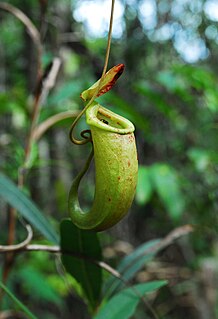
Nepenthes bellii is a tropical pitcher plant endemic to the Philippine islands of Mindanao and Dinagat, where it grows at elevations of 0–800 m above sea level.

Banksia aculeata, commonly known as prickly banksia, is a species of plant of the family Proteaceae native to the Stirling Range in the southwest of Western Australia. A shrub up to 2 m (7 ft) tall, it has dense foliage and leaves with very prickly serrated margins. Its unusual pinkish, pendent (hanging) flower spikes, known as inflorescences, are generally hidden in the foliage and appear during the early summer. Although it was collected by the naturalist James Drummond in the 1840s, Banksia aculeata was not formally described until 1981, by Alex George in his monograph of the genus.

Nepenthes peltata is a tropical pitcher plant known only from the upper slopes of Mount Hamiguitan on the island of Mindanao in the Philippines. It is characterised by a peltate tendril attachment and conspicuous indumentum. The species typically produces ovoid pitchers with a prominent basal crest and large nectar glands on the lower surface of the lid.

Nepenthes micramphora is a tropical pitcher plant known only from Mount Hamiguitan on the island of Mindanao in the Philippines. It is a highland plant growing at elevations of 1100–1635 m.
Stenocarpus cryptocarpus, known as the giant leaf stenocarpus, is a species of trees, of the plant family Proteaceae. They are endemic to some rainforest parts of the wet tropics region of north eastern Queensland, Australia. Notably, juvenile leaves of young trees may reach 115 cm (4 ft) in length.

Xylomelum pyriforme, commonly known as the woody pear, is a species of plant in the family Proteaceae native to eastern Australia. It grows as a large shrub or small tree to five metres high.

Placospermum is a genus of a single species of large trees, constituting part of the plant family Proteaceae. The species Placospermum coriaceum is endemic to the rainforests of the wet tropics region of northeastern Queensland, Australia. Common names include rose silky oak and plate-seeded oak.
Melhania angustifolia is a plant in the family Malvaceae. It is endemic to Zanzibar.
Melhania latibracteolata is a plant in the family Malvaceae, native to East Africa.
Melhania ovata is a plant in the family Malvaceae.
Melhania parviflora is a plant in the family Malvaceae, native to East Africa.
Melhania phillipsiae is a plant in the family Malvaceae. It is native to Africa and the Arabian Peninsula.
Droogmansia pteropus is a plant in the legume family Fabaceae, native to southern tropical Africa.
Melhania velutina is a plant in the family Malvaceae, native to Africa and the Arabian Peninsula.
Alysicarpus glumaceus is a plant in the legume family Fabaceae.
Adenodolichos kaessneri is a plant in the legume family Fabaceae, native to central Africa.
Adenodolichos acutifoliolatus is a plant in the legume family Fabaceae, native to Tanzania.
Adenodolichos paniculatus is a plant in the legume family Fabaceae, native to tropical Africa. The specific epithet means "with panicles", referring to the plant's many-branched inflorescence.
Adenodolichos punctatus is a plant in the legume family Fabaceae, native to tropical Africa.
Adenodolichos rupestris is a plant in the legume family Fabaceae, native to tropical Africa. The specific epithet means "found near rocks", referring to where the species was initially encountered.





